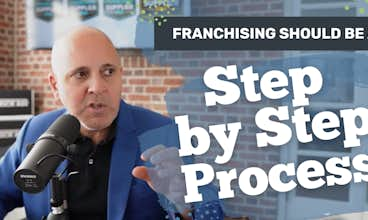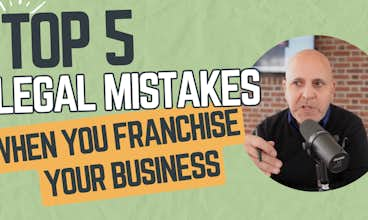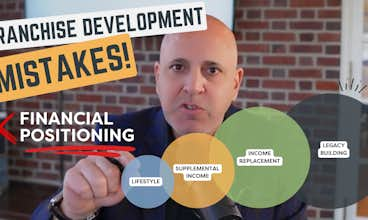Steps and Timing for Franchising
Franchising your business is a process that goes beyond and issuing your FDD and operations manual. When evaluating the steps and timing to successfully franchise your business, focus on a 5 year growth strategy and the following steps and milestones:
- Develop
- Season
- Scale
- Grow
1. Develop a Five-Year Plan for Franchise Success
Although making sure your franchise system has a strong foundation, including a competitively positioned Franchise Disclosure Document (FDD), is a necessary step in the process of franchising your business, achieving success as a franchisor requires more than just completing the documents to start a franchise.
In a highly competitive industry, having a roadmap for success is critical for new and emerging franchisors. By defining your vision and establishing a timeline for achieving your goals as an entrepreneur, you can map out your brand’s future in a manageable way that’s easy to understand – and stick to.
It’s important to remember that success doesn’t happen overnight, especially when it comes to franchising. Because success in the franchise industry can take years, creating a five-year franchise plan for success can help new franchisors maintain their business development strategy over time.
2. Break your Franchise Success Plan into Manageable Milestones
When thinking about success as a new or emerging franchisor, it’s critical to understand that franchising your business is only the first step in a years-long process.
By developing a framework that allows you to divide your business development goals into small, manageable phases across a five-year timespan, you can increase the chances of achieving your goals over the long term.

Phase 1: Develop
During your first 90 to 120 days as a franchisor, it’s crucial to focus on building a rock-solid FDD and legal foundation for your new franchise system.
During this time, consult an experienced franchise attorney to develop your brand’s legal infrastructure and draft a competitively positioned FDD. The development phase should also include taking time to understand your legal obligations as a franchisor and making sure your franchise brand’s legal documents are in order. This includes, but isn’t limited to, the following documents:
Your brand’s franchise operations manual
Your franchise system’s franchise agreement
Any financial statements necessary for the franchise registration and/or sales process
Trademark applications and/or registrations necessary to protect your brand
Any franchise registration applications or notices that might be required in the franchise registration states
Because the franchise industry is heavily regulated at both the federal and state levels, establishing a strong legal foundation early on can help insulate your brand from legal issues in the future.
Phase 2: Season
From your fourth month to your second year in business, focus on “seasoning” your new franchise system – that is, improving your brand’s communication and processes while you continue to learn and mature as a franchisor.
Use this time to make incremental improvements to your franchise sales website, develop a compelling brand story and cultivate your founder story. During the seasoning phase, it’s also important to refine your organic franchise sales process by identifying effective ways to communicate the unique opportunities your brand offers prospective franchise buyers – and over-supporting them once they’re onboard.
When determining the ways your franchise system can transform the lives of future franchisees, consider the following:
What sets your brand apart from others in the same industry?
How do your unit economics stack up against competitors?
What financial benefits do your territories offer franchisees?
Why you – and why now?
By making continuous improvements to the way you reach prospective franchise buyers – and by supporting new franchisees once they come on board – you can establish a successful, sustainable business model for your franchise system over time.
Phase 3: Scale
Between your second and fourth year in business as a franchisor, scaling and growing your franchise system should take priority. At this point in the franchising journey, it’s critical to ensure your brand has the following assets solidly in place:
A strong, recognizable brand
Unique differentiators that set your franchise apart from competitors
A compelling brand story and founder story
Pioneering franchisees with solid unit-level economics that can validate your franchise system
By ensuring that your brand is well-established and your first few franchisees can provide prospective franchise buyers with validation about your brand, your franchise system will be ready to scale to new locations domestically – or even internationally.
Phase 4: Grow
The final phase of your five-year success plan should take place between your fourth and fifth years in business as a franchisor. During this time, it’s important to focus specifically on growth.
Key indicators that your brand is ready to grow sustainably include the following:
At least 10 successful franchisees with strong unit economics that can validate the franchise brand
A corporate team that supports franchisees in their journey
Continuous refinement of unit economics, including support for franchisees in boosting sales and achieving higher profit margins
After you’ve determined that your franchise system is positioned for growth, it’s time to take franchise sales to the next level. During year five and beyond, franchisors can benefit from engaging with franchise brokers and franchise sales organizations – both valuable resources that can connect seasoned franchisors to a network of qualified, properly capitalized prospective franchisees.
3. Evaluate Your Success
Although having a five-year plan in place is critical for success in the franchise industry, it’s also important to ensure progress as you implement that plan over time. To evaluate whether your brand is moving in the right direction, look for the following indicators:
Multi-unit franchisees. There’s no stronger validator than franchisees who want to purchase more than one territory.
Strong unit-level economics. As an important part of the FDD, Item 19 financial performance representations that demonstrate strong unit economics, good franchisee profitability and strong brand positioning are a key indicator of success.
Identifiable leadership, values, culture and mission. Does your sales website effectively communicate your brand’s leadership, core values, assets, and specific ways the brand can benefit franchisees?
By taking the time to develop and follow a five-year success plan, emerging franchisors can build a thriving, successful franchise brand in less than a decade – while transforming the lives of franchisees in the process.
Want to learn more about franchising your business? Let's talk!








